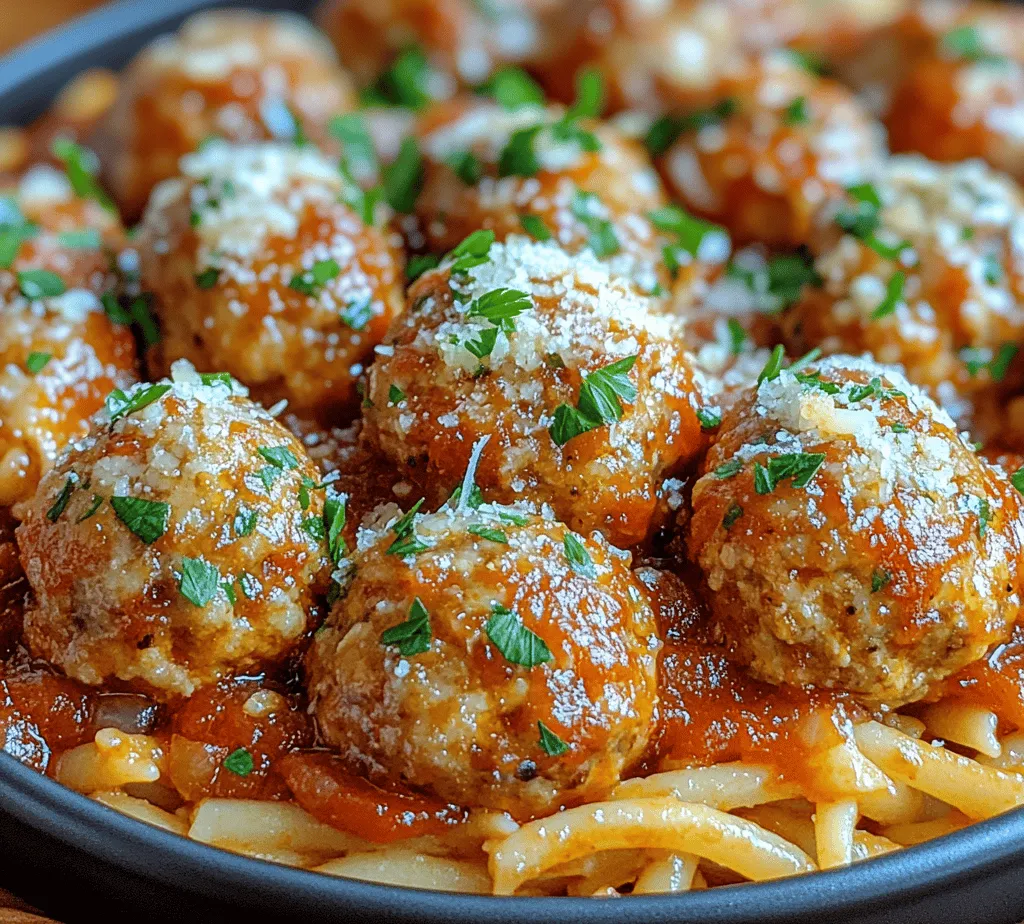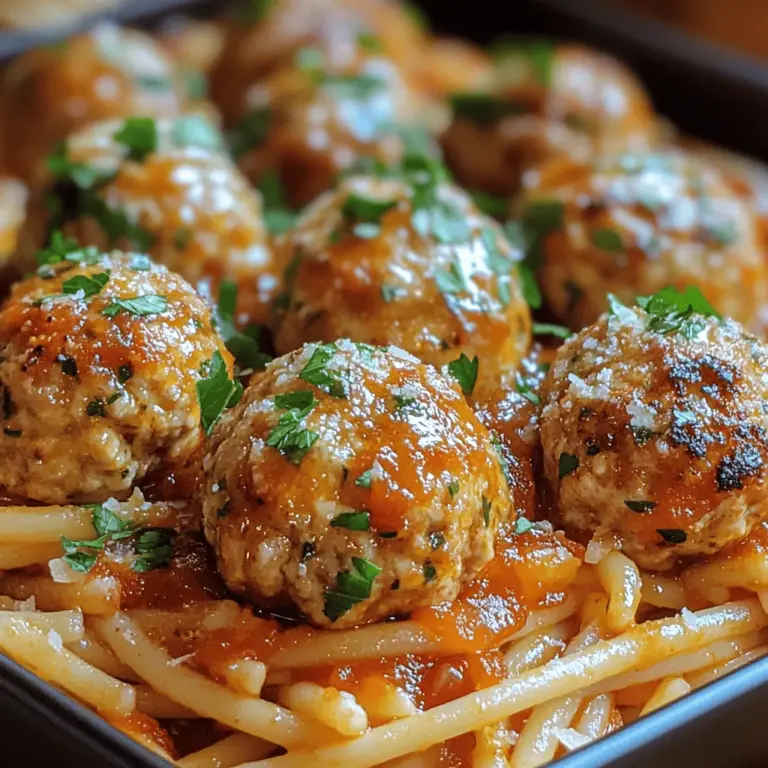When it comes to comfort food, few dishes evoke the same warmth and satisfaction as a plate of meatballs. However, traditional meatballs, often made from beef or pork, can be heavy and high in fat. Enter turkey meatballs: a leaner, healthier, yet equally delicious alternative that allows you to savor all the flavors you love while keeping your meal light. In this article, we’ll explore the wonderful world of juicy turkey meatballs, highlighting their nutritional benefits, versatility, and the essential techniques for creating the perfect batch.
The Health Benefits of Ground Turkey
Ground turkey has gained popularity as a healthier substitute for red meats, and for good reason. Lean ground turkey, particularly the breast meat, boasts a significantly lower fat content compared to ground beef and pork. While a typical serving of ground beef contains around 20% fat, lean ground turkey can be as low as 7% fat, making it an excellent choice for those looking to reduce their fat intake without sacrificing flavor.
Moreover, turkey is an excellent source of high-quality protein, which plays a crucial role in muscle repair and growth. It also contains essential nutrients such as B vitamins (including niacin and B6), selenium, and zinc, which contribute to overall health and wellness. By opting for turkey meatballs, you can enjoy a hearty meal that aligns with your health goals.
Versatility of Turkey Meatballs
One of the most remarkable aspects of turkey meatballs is their versatility. They can be adapted to fit various cuisines and meal preparations, making them a go-to option for busy weeknights or meal prep. Whether you want to serve them with spaghetti and marinara sauce for a classic Italian dish, toss them in a tangy barbecue sauce for sliders, or incorporate them into a stir-fry, turkey meatballs can take on a world of flavors.
Additionally, turkey meatballs can be made with a variety of ingredients to suit different dietary needs. For those following gluten-free diets, substituting traditional breadcrumbs with gluten-free options is straightforward. You can also experiment with spices and herbs to create unique flavor profiles that cater to your personal taste.
Understanding the Ingredients
Creating the perfect turkey meatballs starts with understanding the ingredients that contribute to their taste and texture. Each component plays a crucial role in ensuring your meatballs are not only flavorful but also juicy and tender.
Importance of Choosing Lean Ground Turkey
When selecting ground turkey, it’s essential to choose a lean option. Look for packages labeled as “lean” or “extra lean,” which typically contain a higher proportion of white meat. Lean turkey offers a great balance of flavor and nutrition without the excess fat that can make meatballs greasy.
In comparison with beef and pork, lean turkey is a superior choice for health-conscious individuals. While ground beef can provide a rich, savory taste, it also comes with higher saturated fat levels. Ground pork, though flavorful, can be similarly high in fat. Lean turkey, on the other hand, provides a mild flavor that readily absorbs the seasonings and ingredients you mix in, allowing for a lighter, yet satisfying dish.
The Role of Breadcrumbs in Meatballs
Breadcrumbs are a classic ingredient in meatball recipes, and they serve multiple purposes. They help bind the ingredients together, prevent the meatballs from falling apart during cooking, and contribute to the overall texture. The type of breadcrumbs you choose can significantly impact the final product.
Whole wheat breadcrumbs are a healthier option compared to their white counterparts, providing additional fiber and nutrients. If you’re following a gluten-free diet, there are plenty of gluten-free breadcrumb alternatives available, such as almond flour or crushed gluten-free crackers. Regardless of the type you choose, breadcrumbs can help maintain moisture in your turkey meatballs, ensuring they remain juicy and tender.
Flavor Enhancements with Parmesan and Fresh Herbs
Adding grated Parmesan cheese to your turkey meatball mixture can elevate the flavor profile while also contributing to moisture. The cheese melts during cooking, creating a rich, savory taste that complements the turkey beautifully.
Incorporating fresh herbs like parsley can further enhance the dish. Parsley adds a bright, fresh flavor that cuts through the richness of the meat and cheese, while also providing a pop of color. Garlic, whether minced or in powder form, is another essential ingredient that adds depth and aroma to your meatballs.
The Impact of Seasonings on Flavor Profile
Seasonings are the backbone of any meatball recipe, and using a well-balanced blend can transform your turkey meatballs from ordinary to extraordinary. Italian seasoning, which typically contains a mix of basil, oregano, rosemary, and thyme, is a popular choice that pairs beautifully with turkey.
Salt and pepper are fundamental in any dish, as they help to enhance the natural flavors of the ingredients. When seasoning your meatball mixture, be sure to taste it before cooking to ensure a well-rounded flavor. Remember, the goal is to create a balanced profile that highlights the turkey while complementing the other ingredients.
Step-by-Step Recipe Instructions
Now that we understand the importance of each ingredient, let’s dive into the first steps of making juicy turkey meatballs.
Prepping for Success: Preheating the Oven
Before you begin mixing your ingredients, it’s crucial to prepare your cooking environment. Preheat your oven to 400°F (200°C). The right oven temperature is key to achieving perfectly cooked meatballs that are golden brown on the outside and juicy on the inside.
While the oven is heating up, prepare a baking sheet with parchment paper. This will not only prevent the meatballs from sticking but also make for easier clean-up. If you don’t have parchment paper, you can lightly grease the baking sheet with cooking spray or olive oil.
Mixing the Ingredients: Technique Matters
The success of your turkey meatballs lies in how you mix the ingredients. In a large mixing bowl, combine your lean ground turkey with the breadcrumbs, grated Parmesan, minced garlic, chopped parsley, and your chosen seasonings.
When mixing, it’s essential to avoid overmixing the turkey. Overworking the meat can lead to tough meatballs. Instead, use your hands or a fork to gently combine the ingredients until just mixed. The goal is to evenly distribute the flavors without compromising the texture of the meat.
Once the mixture is combined, form the meatballs into uniform sizes—about 1 to 1.5 inches in diameter works well. This ensures they cook evenly. Place the formed meatballs on the prepared baking sheet, giving them enough space to expand while cooking.
As you work through these initial steps, remember that the joy of cooking lies in experimentation and personalization. Feel free to adjust the seasonings, add your favorite herbs, or even incorporate vegetables into the meatball mixture for added nutrition. With turkey meatballs, you have the flexibility to create a dish that not only satisfies your cravings but also aligns with your health goals. Stay tuned for the next part of this article, where we will delve into the cooking process and additional tips for achieving the ultimate juicy turkey meatballs.

The Importance of Using Hands for a Better Mixture
When it comes to creating juicy turkey meatballs, using your hands is not just encouraged; it’s essential. Mixing the ingredients by hand allows for better incorporation without overworking the meat. This gentle handling ensures that the meatballs maintain a tender texture while also allowing the flavors to meld together thoroughly. Start by combining the ground turkey with breadcrumbs, herbs, spices, and any vegetables or aromatics you choose. The warmth of your hands helps to activate the ingredients, particularly if you’re using fresh herbs or garlic, resulting in a more flavorful meat mixture.
Forming Perfect Meatballs
Once your mixture is well-combined, the next step is to form your meatballs. This is where practice makes perfect. Begin by scooping a portion of the mixture with your hands. A helpful tip is to use a cookie scoop or an ice cream scoop to create uniform sizes, which will ensure even cooking. The ideal meatball size is typically about 1 to 1.5 inches in diameter. This size is perfect for a balance between cooking time and juiciness.
Ideal Size for Meatballs and Spacing on the Baking Sheet
After forming the meatballs, it’s crucial to arrange them properly on your baking sheet. Ensure there’s enough space between each meatball, about one inch apart. This spacing allows the hot air to circulate around each meatball, helping them cook evenly and develop a nice crust without steaming. If you crowd the baking sheet, you may end up with soggy meatballs instead of the desired juicy texture.
Tips for Rolling Meatballs to Ensure They Hold Shape
To prevent your meatballs from falling apart during cooking, ensure your hands are slightly damp when rolling them. This technique minimizes sticking and helps maintain the shape. Additionally, avoid packing the meat mixture too tightly; gentle pressure is key. If you find the mixture is too wet, you can add a bit more breadcrumbs to help with binding. Allow the meatballs to rest for a few minutes after rolling, which can help them hold their shape better during the cooking process.
Baking the Meatballs for Juiciness
Now that your meatballs are formed and arranged, it’s time to bake them. Preheat your oven to 400°F (200°C). Baking at this temperature allows the meatballs to develop a nice golden crust while keeping the inside moist and juicy.
Optimal Baking Time and Internal Temperature for Safety
The ideal baking time for turkey meatballs is about 20-25 minutes. However, the most important factor is the internal temperature. Use a meat thermometer to ensure they reach an internal temperature of 165°F (73.9°C). This temperature ensures that any harmful bacteria are eliminated, making your meatballs safe to eat while still retaining their juiciness.
The Effect of Olive Oil on the Meatball’s Final Texture
Before placing the meatballs in the oven, consider drizzling a little olive oil over them. This not only adds flavor but also enhances the final texture, creating a crispy surface while keeping the interior moist. Olive oil is a healthy fat that contributes to the overall flavor profile of the dish without adding unnecessary calories.
Simmering in Marinara Sauce
For an extra burst of flavor, consider simmering your baked turkey meatballs in marinara sauce. This method allows the meatballs to absorb the flavors of the sauce while providing a moist cooking environment.
How Simmering Enhances Flavor Development
Simmering meatballs in sauce not only deepens the flavor but also adds a delightful richness. The acidity of the marinara can help to tenderize the meatballs further, making them even more enjoyable. To do this, simply transfer the cooked meatballs into a pot of marinara sauce after baking and let them simmer for about 10-15 minutes. This step is crucial for developing those hearty, comforting flavors that make turkey meatballs a favorite family dish.
Best Practices for Transferring Cooked Meatballs to Sauce
When transferring the meatballs to the sauce, use a slotted spoon to avoid excess grease and to keep the meatballs intact. Gently lower each meatball into the simmering sauce to prevent splashing and ensure they remain whole. Allow them to simmer gently, which will also help meld the flavors together beautifully.
Serving Suggestions
Creative Ways to Serve Turkey Meatballs
Now that you’ve prepared your juicy turkey meatballs, let’s explore some creative serving suggestions. These meatballs are versatile and can be enjoyed in various ways, making them suitable for any meal.
1. Over Whole Grain Pasta: A classic pairing is serving meatballs over a bed of whole grain spaghetti. The combination of the hearty marinara sauce and the meatballs creates a satisfying dish that is both filling and nutritious.
2. Zucchini Noodles: For a lighter, low-carb option, serve the meatballs over spiralized zucchini noodles. This dish not only provides a fresh twist but also adds an extra serving of vegetables to your meal.
3. Standalone Dish: Enjoy the meatballs by themselves with a drizzle of sauce on top for a simple yet delicious dish. This approach is perfect for those looking for a protein-packed meal without the carbs.
Pairing with Sides Like Salads or Vegetables for a Balanced Meal
To create a well-rounded meal, consider pairing your turkey meatballs with a side salad or steamed vegetables. A fresh salad with mixed greens, cherry tomatoes, and a light vinaigrette complements the richness of the meatballs nicely. Alternatively, roasted or steamed vegetables such as broccoli, green beans, or asparagus add color and nutrition to your plate.
Garnishing for Presentation
Aesthetics play a significant role in food presentation. A well-garnished dish can elevate the overall dining experience. For your turkey meatballs, consider garnishing with freshly chopped parsley or basil for a pop of color and freshness. A sprinkle of grated Parmesan cheese can also enhance flavor and give a touch of elegance to the dish.
Nutritional Information
When it comes to healthy eating, turkey meatballs are a fantastic choice. Here’s a breakdown of the nutritional content per serving (approximately 4 meatballs):
– Calories: 220
– Protein: 24g
– Fats: 10g
– Carbohydrates: 10g
Health Benefits of the Ingredients Used
Turkey is a lean protein source, making these meatballs lower in fat compared to traditional beef or pork meatballs. The use of whole grain breadcrumbs adds fiber, while herbs and spices contribute antioxidants and other beneficial compounds. Additionally, using olive oil provides heart-healthy fats, making this dish a nutritious option for families.
Comparison with Traditional Meatball Recipes Regarding Nutrition
Compared to traditional meatball recipes, which often use higher-fat meats and additional fillers, turkey meatballs offer a healthier alternative without sacrificing flavor. By incorporating wholesome ingredients and cooking methods, you can enjoy this classic comfort food guilt-free.
Conclusion
Juicy turkey meatballs are not only delicious but also a healthier alternative to traditional meatballs. With their tender texture and rich flavors, they make for a fantastic family-friendly meal option that everyone will love. Whether served over pasta, in a sub, or on their own, these meatballs are versatile enough to suit different dietary needs and preferences.
Encouraging you to try this recipe, you’ll find that it is easy to prepare and can be dressed up or down to suit any occasion. The flexibility of this dish allows for variations in flavors and ingredients, making it a staple in your meal rotation. Enjoy the process of creating these delightful turkey meatballs, and savor the satisfaction of a wholesome, home-cooked meal!


